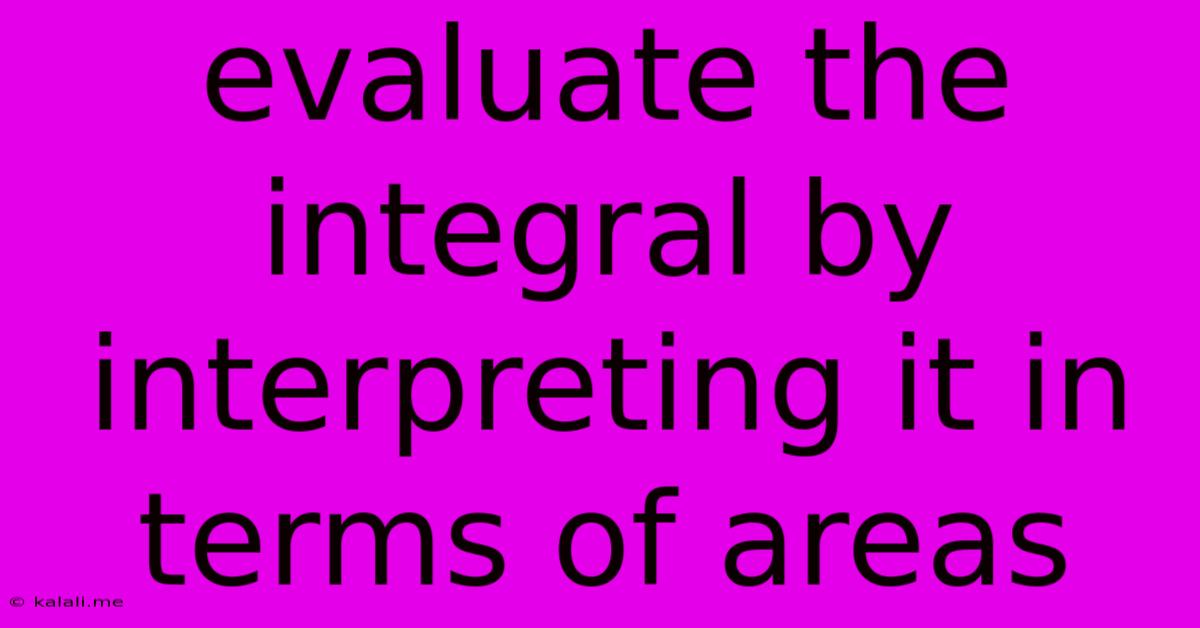Evaluate The Integral By Interpreting It In Terms Of Areas
Kalali
May 24, 2025 · 3 min read

Table of Contents
Evaluating Integrals by Interpreting Them as Areas
This article explores a fundamental concept in calculus: evaluating definite integrals by interpreting them geometrically as areas. Understanding this connection provides a powerful visual tool for solving certain integrals, especially those involving simple geometric shapes. We'll delve into the method, explore some examples, and highlight its limitations. This approach is particularly useful for building intuition before tackling more complex integration techniques.
What is a Definite Integral?
Before we jump into the geometric interpretation, let's briefly review the definition of a definite integral. The definite integral of a function f(x) from a to b, denoted as ∫<sub>a</sub><sup>b</sup> f(x) dx, represents the signed area between the curve y = f(x) and the x-axis, from x = a to x = b. The area above the x-axis is considered positive, while the area below is considered negative.
Interpreting Integrals as Areas: The Visual Approach
The key idea is to visualize the region bounded by the curve, the x-axis, and the vertical lines x = a and x = b. If the function f(x) is non-negative (i.e., f(x) ≥ 0) on the interval [a, b], the integral directly represents the area of this region. If f(x) is negative, the integral represents the negative of the area. If the function is both positive and negative on the interval, the integral is the net signed area; positive areas are added, and negative areas are subtracted.
Examples: Putting it into Practice
Let's illustrate this concept with some examples:
Example 1: A Simple Rectangle
Consider the integral ∫<sub>1</sub><sup>3</sup> 2 dx. This represents the area under the line y = 2 from x = 1 to x = 3. This region is a rectangle with height 2 and width (3 - 1) = 2. Therefore, the area (and the value of the integral) is 2 * 2 = 4.
Example 2: A Triangle
Let's evaluate ∫<sub>0</sub><sup>4</sup> (x) dx. This integral represents the area under the line y = x from x = 0 to x = 4. This region is a right-angled triangle with base 4 and height 4. The area (and the integral) is (1/2) * 4 * 4 = 8.
Example 3: A Combination of Shapes
Now consider something a little more complex: ∫<sub>-1</sub><sup>2</sup> |x| dx. This represents the area under the absolute value function from x = -1 to x = 2. This area consists of two triangles: one from x = -1 to x = 0 with area 1/2, and another from x = 0 to x = 2 with area 2. The total area, and thus the value of the integral, is 1/2 + 2 = 2.5.
Limitations of the Geometric Approach
While this method is intuitive and powerful for simple functions, it has limitations. It becomes significantly more challenging, if not impossible, to accurately determine areas for complex functions that don't form easily recognizable geometric shapes. For these cases, more advanced integration techniques are necessary.
Conclusion
Interpreting definite integrals as areas offers a valuable visual and intuitive understanding of the concept. This approach is particularly helpful for building a strong foundational understanding and solving integrals involving simple geometric shapes. However, its applicability is limited to functions that yield readily identifiable areas. For more complex integrals, numerical methods or advanced integration techniques are required. Remember, understanding the fundamental relationship between integrals and areas is crucial for mastering calculus.
Latest Posts
Latest Posts
-
Knight And Maid Murder The Monarchs And Have An Affair
May 25, 2025
-
Being A Baby Feels Great Logo
May 25, 2025
-
Is Not Utf 8 Encoded Falling Back To Latin1
May 25, 2025
-
Car Has Power But Wont Start No Click
May 25, 2025
-
Ncrete Mathematics A Foundation For Computer Science Prerequisties
May 25, 2025
Related Post
Thank you for visiting our website which covers about Evaluate The Integral By Interpreting It In Terms Of Areas . We hope the information provided has been useful to you. Feel free to contact us if you have any questions or need further assistance. See you next time and don't miss to bookmark.